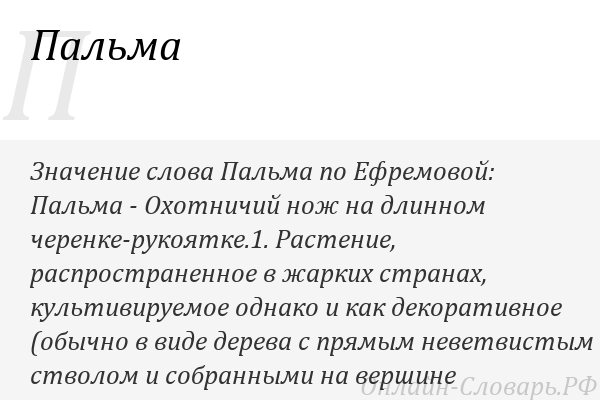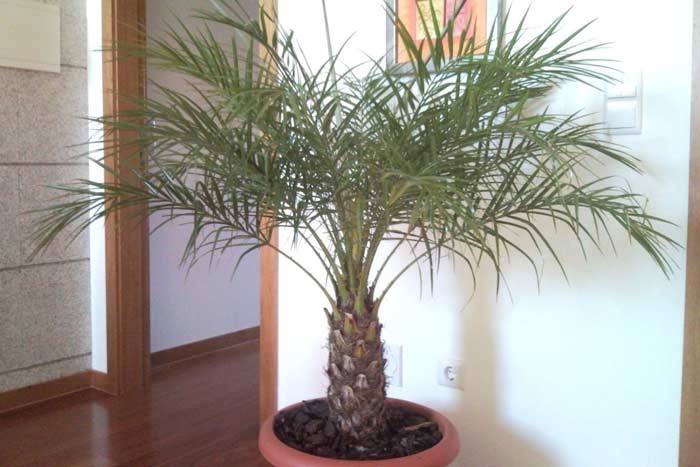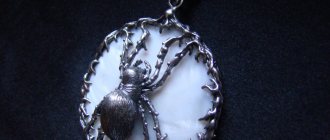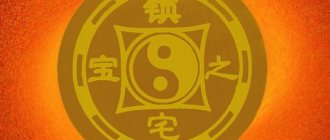| palm ---- A family of tree-like plants, mostly with a nonbranched trunk and a crown of radially diverging branches at the top; sometimes lianas. Known about 3,400 species, grouped into about 250 genera, distributed mainly in the tropics. Coconut, date and oil palm are cultivated. For obvious reasons, the date palm was highly valued in the arid areas of the southern Mediterranean. In Africa and West Asia it is an important food product. In symbolic texts and images, as a rule, the date palm is implied with the general symbolism of victory, superiority, glory, longevity, resurrection and immortality. It also signifies the solar origin, jubilation, honesty. Because of its shape (flat trunk and radial crown) the palm has been a solar, cosmological and triumphal symbol in the Middle East since antiquity: it was considered the Tree of Life in Egypt and Arabia. Being self-reproducing, it is identified with the androgynous. As a source of food, one of its varieties, the date palm symbolizes the fertility and generosity of the gods. As an itiphallic symbol - means male strength and fertility, but if the palm is depicted with dates, it serves as a symbol of femininity (China and West Asia). Accordingly, the palm was associated not only with the sun cult (an attribute of Apollon in ancient Greece), but also with such goddesses as Astarte and Ishtar. The palm tree, which bears good fruit in old age, symbolizes longevity and prosperity in old age. Gods, demiurges or cultural heroes create the first humans from a variety of materials: the skeleton of animals (in some myths of North American Indians of the Algonquin language group the demiurge Manabush creates humans from the skeleton of animals, fish, birds), nuts (the Melanesian A. m. describes the use of coconuts, in a Peruvian Indian myth - palm tree nuts, etc.). Aswatha - the sacred fig tree, a symbol of integral and life-easing knowledge. Contrasts with the Old Testament concept: "knowledge multiplies sorrow." In the mystical tradition - apotheosis, triumph, movement and change blowing outward, outward. If you bring the male and female branches of the palm tree closer together, they will lean toward each other. The palm hidden between the two mountains signifies the tradition of the occult. The palm tree is the tree of life, and in Christians it is a symbol of martyrdom and purity. Basic meanings: |
Egypt
The palm is a "calendar" tree, giving a new branch once a month. Therefore its branches symbolized the time in general and its duration in particular. So on the door of the temple of Medamud (Egyptian Museum, Cairo) is depicted as Sesostris III receives from Horus and Seth (Lower and Upper Egypt) a palm branch - a label for a long reign.
One myth tells us that Thoth supposedly arose from the head of Seth after the latter mistakenly swallowed the seed of Horus. The cosmic implication of this picture is clearly expressed by the Egyptologist Bonnet: "Through the power of the god of light a disc of the full moon bursts out of Seth, the power of darkness." The relation to the moon allows Toth to become a "master of time" and a "counter of the years." Hence his attributes - the writing instrument and the palm branch. At various times Thoth was called the tongue or the heart of Ra. As the protector of Osiris, he also becomes the helper of the dead, which led to his comparison with Hermes in the transition to Greek mythology.
The number one thousand (ideogram in the form of a lotus flower) is a symbolic expression for a large number and occurs frequently in this sense in the list of sacrifices. The character 100000 is a tadpole, which was found in the Nile in enormous numbers. For the million is the image of the kneeling god Hakh; it is often given as a symbolic figure for the infinite number of years (eternity) on vessels and decorations; in this case, he carries in his outstretched hands a palm branch. Hah (the personification of infinity and eternity) has a palm branch as his head ornament.
The goddess Hathor (her symbol was also a sycamore) was the queen (or goddess Nut) of the date palm: she (or goddess Nut) got food and drink from it. It is not uncommon to see images of the divine essences of female tree species (the mentioned goddesses of Heaven) in the form of birds presenting water and fruit to the dead or their souls. The date palm, or sycamore, is thus considered to be the Tree of Life: whoever drinks the water of life and eats the fruits of heaven, will live even after death. It is no coincidence that the Egyptians put palm fronds on coffins and mummies.
The columns in the form of date palms, characteristic of ancient Egyptian architecture, also symbolized the Tree of Life. The entire temple is a stone symbol of peace. The lower part symbolizes the earth, from which plants rise (papyrus, lotus and palm tree in the form of columns); the ceiling is the firmament, and therefore decorated with stars.-not only designating structures of sacred character, but also a symbol of "sacredness" in every conceivable sense. le, and the sublime desire to create some kind of spiritual sphere among the everyday life. Under this nickname (the word "seshat" is a grammatical form of the feminine form of "sesh" - "scribe"), "referring to the house of books", the goddess of the art of writing is venerated. She or one of the priests is believed to mark out the plan of the temple with a measuring rope when laying the temple; thus Seshat is also the "mistress of builders". her most significant function is to write down the years of reign and jubilees allotted to the king. her not very detailed defined headdress looks like a seven pointed star with a handle (the moon sickle?), often topped with two falcon feathers. She usually holds a palm branch in her hand and often wears a panther skin over her dress.
Mythical plants
October 18, 2021 at 12:12 pm
Let's take a look at what are known mythical plants in Indian traditions. The world tree
in the Indo-European mythological model of the world is a symbol of the unity of the three worlds - the upper (heavenly), middle (terrestrial) and lower (underground). According to these beliefs, the crown of the World Tree reaches the heavens, the roots go down into the underworld, and the trunk marks the center of the earth, its axis. In relation to the surface of the earth, the trunk of the World Tree symbolizes the center of the main directions: east, west, north and south. Therefore, the World Tree is surrounded by four more gods with their sacred animals, denoting the sides of the world. In Indian mythology the axis of the three worlds is Mount Meru, but the symbolism of the World Tree is also present in many other myths.
Hindu mythology often refers to a tree growing in the Primordial Ocean. According to some sources, this is the Vetas tree, which grew during the creation of the world from fragments of the shell of the Golden Egg. Apparently, it has a real prototype, for Vetas trees are mentioned in many sources as growing in nature. According to other sources, Narayana, the Supreme God, is lying on a leaf of a banyan tree floating on the primal waters (Nara) and sucking his toe, symbolizing eternity. In another version of this myth, Narayana in the image of a baby is lying on the branches of a banyan tree growing out of the primordial ocean.
In the Upanishads the metaphor of creation is ashvattha (pippal), "the root of which is upward and the branches grow downward. In the mythological symbolism of the Mahabharata the tree nyagrodha (Sanskrit nyag-rodha "growing downwards") appears as an equivalent of the "world tree". The name is explained by the specific structure of this plant: its branches, its roots, go down and grow into the ground. Ashwattha, Pippal, Banyan, Nyagrodha are the names of the plants of the genus Ficus, which will be described later.
Mythical plants. Parijata tree.
The Parijata tree obtained by plowing the ocean was planted in his garden by the god Indra, king of the gods and ruler of the paradise world Indraloki. The bark of the tree was of gold, with its burgeoning young leaves of the color of copper and its branches with numerous clusters of fragrant fruits. Rishi Narada brought the flower of the tree as a gift to his friend Krishna, who gave it to one of his wives, Rukmini. Narada informed Krishna's other wife, Satyabhama, and was surprised that the flower was not presented to her as his favorite wife. Satyabhama, of course, was upset, and then Narada advised her to ask Krishna for the Parijata tree itself as a gift to plant near her house. But the tree belonged to Indra, who would not part with it willingly, and Krishna would have to steal Parijata. Having given this advice, the sage flew to Indra and warned him to guard the tree more strictly, after which he waited for developments.
Satyabhama retired to the "room of wrath" where wives who were feeling unhappy retreated. When Krishna came to her, she asked for a Parijata tree as proof of her love. After sneaking into Indra's garden, Krishna started digging up Parijata to take away the tree with its roots and plant it near Satyabhama's house. Then Indra appeared, but when he saw who the kidnapper was - Krishna was an avatar of the god Vishnu - he graciously allowed the tree to be taken away. Krishna proved his love to both wives by planting the tree in Satyabhama's garden, but its branches extended over Rukmini's garden, dropping their flowers there. After Krishna's death, the city of Dvaraka, where he lived, sank into the ocean, and the Parijata tree returned to heaven.
Probably before it "returned to heaven," this wonderful tree had time to multiply, because the Parijata, or har singhar, trees still grow in India. Their flowers resemble jasmine, but the corolla tubes are colored orange. Aswagosa, the spiritual preceptor of King Kanishka, while describing the jungles of the lower belt of the Himalayas, mentions many beautiful trees, including the parijata, shining in their majesty and towering regally above other trees laden with luxuriant blossoms. They are widespread in the gardens of eastern Rajasthan.
Mythical plants. Kalpa vriksha.
Indian epic often mentions the Kalpa-vriksha, translated "tree of desires," whose image is depicted in ancient Indian sculptural decorations. According to legend, one must stand under the branches of the tree, and it will give everything that is asked of it. Kalpa-vriksha is dedicated to one of the earliest sculptural representations of vegetation in India. It was created in Besnagar in the third century BC and is now in a Calcutta museum. M. Radhava describes this tree as a banyan tree, at the foot of which are depicted jars and a shell from which coins and lotus flowers fall. The kalpa-vriksha is also often called the coconut palm.
In the forest of Vrindavan, Krishna's favorite playground as a child, there are believed to have been kalpa-vriksha trees, but it has not been ascertained what they were. According to the Krishnaites, these trees did not grant the wishes of every person who approached them with a request. The petitioner first had to become a devotee of Lord Krishna. The wish tree is impartial and free from material attachments. It grants the fulfillment of desires only to those who deserve such mercy.
Antiquity
Dedicated to Jupiter.
You, who wish to pluck the branches of a palm tree, must, though you do not know it, overcome the steep slopes of the mountains. (Latin inscription).
The Greek name of the palm tree "Phoinix" alludes to the association with the sun and Helios-Apollo (see Phoenix). Palm
served as an emblem of Apollo of Delphi and Delos, and on the island of Delos (Asteria), which accepted the beloved of Zeus, was venerated the palm tree under which Summer was resolved. [Catlim. Hymn. IV 55-274; Hymn Not. I 30-178].
Never dropping its leaves, the palm tree is constantly adorned with the same greenery. Such is the power of this tree that people consider acceptable and suitable for depicting victory. (Plutarch).
The goddess of victory Nike (lat. Victoria) was often depicted with a palm branch.
4. Eros and Antheroth. Antheroth, the brother of Eros, was known in antiquity. Venus, who realized that her young son had stopped growing, was told that only a brother could help the trouble. Thus Eros obtained a brother, Antheroth, who came to symbolize mutual love, that is, the kind that grows and strengthens. Eros and Antheroth are depicted together, either fighting, perhaps for the possession of the palm branch, or making peace and embracing. Their struggle meant, it was thought, not discord, but the strength of their feelings for each other. Renaissance humanists distinguished between two kinds of love - heavenly love, which grew with reflection on God, and earthly love, that is, ordinary, worldly or sexual love. Typically, Eros and Anthero are depicted as two Venus twins, or Cupid twins. Eros' struggle with Antheroth symbolized these two aspects of love.
Where best to place.
Great places to place:
- A hallway or hallway. The palm tree will protect against energy negativity entering the house through the front door, and will immediately set guests in a positive mood.
- Living room is also a good choice. The tree will create a cozy and bright atmosphere in which you can relax, talk, read, or celebrate holidays. Often an armchair and a coffee table are placed nearby, sometimes - a small fountain, hang sconces with soft lighting, to get a nice corner for relaxation and recovery.
- If you have a special room for physical training, place a plant there. It will help to focus on the process, open your second breath and greatly improve your results.
A palm tree is ideal for fitness clubs, beauty salons, schools, offices, libraries. It will successfully decorate large lobbies, halls and corridors provided there is a favorable temperature and no drafts.
Where it is not recommended to place:
- In the bedroom - active cheerful energy can be too stormy for a peaceful night's sleep.
- The nursery is also not the right place. Quick-tempered babies in this neighborhood can turn into true monkeys.
- In the kitchen, a large tree will be a nuisance and will suffer from soot, heat, drafts.
If the house has a separate dining room - you can easily put a palm tree there. In addition to decorating the interior, it will perform another important function - to normalize appetite and help get rid of excess weight, as well as create an additional incentive to keep fit, reminding of the hot countries, the beach and summer.
Christianity
For this reason (fertility and mercy of the gods, fecundity) the date has become a biblical symbol of those chosen ones who will receive blessing in Heaven. Psalm 91:13 says, "The righteous man blossoms like a palm tree, towering like a cedar on Lebanon. Christianity: a righteous man who "will blossom like a palm tree"; immortality, with this meaning it is sometimes depicted along with the Phoenix; the Palm Branch. Originally a symbol of military victory, it is carried in triumphal processions; it was adopted by the early Church as a symbol of Christ's victory over death. With the Romans, the palm branch was traditionally considered a symbol of victory. This meaning was introduced into Christian symbolism, where the palm branch was used as an indication of the martyr's victory over death. Pictures depicting martyrs often feature palm trees. The use of palm branches in victory ceremonies (and as a reward for the victorious gladiator) was borrowed from the Christian tradition and signified Jesus Christ's victory over death; from the 4th century angels are depicted with sacred radiance - a halo - and wings, often as young men in white robes, with wands, lilies, palm branches, swords of fire (for destroying the devil),
Christ is often depicted with a palm branch signifying his victory over death, but more often the palm branch is associated with his entry into Jerusalem: "On the next day the multitude of the people who came to the feast, when they heard that Jesus was going to Jerusalem, took the palm branches and came out to meet him and exclaimed: Hosanna, blessed is he who comes in the name of the Lord, the King of Israel! (Jn. 12:12-13). His entry into Jerusalem is celebrated on Palm Sunday (Palm Sunday in Russia). palm branches were also used to greet Jesus as he entered Jerusalem (in the Christian celebration of Palm Sunday, "palm earrings" have their place; in Russia this day is called Palm Sunday, respectively, "palm buds". - Ed.). Palm (originally "palm") Sunday is celebrated in honor of Christ's entry into Jerusalem. In Christian symbolism, ashes are a symbol of repentance. On Ash Wednesday (day of repentance), the first day of Lent, ashes placed on the forehead express that the essence of this period is repentance. These ashes remain from palm trees burned after Palm Sunday. The ashes also symbolize the death of the human body and the mortality of earthly life,
In Christian art the palm (a symbol of longevity or immortality) has become an attribute of many saints and martyrs, Since early Christianity the "palm of precedence" of the martyr (signifying his spiritual victory) and the verdant palm of the expected paradise at the end of his earthly life, also in a stylized connection with the lily and vine motifs, are often depicted. It is very often found in art as an attribute of a martyr and is an identifying mark. Catherine of Alexandria, Justina of Antioch (in combination with the cross), Peter the Martyr, Agatha, Laurentius, Thecla, the holy soldiers Ananias of Siena and Mauritius.
Ansanus (d. 303). A Christian martyr saint, a Sienese nobleman who became a Christian at the age of twelve and preached the Christian faith while still very young. He was betrayed by his father to the emperor Diocletian, who, according to tradition, immersed him in boiling oil before executing him. He died at the age of twenty. Among his attributes are the banner of the Resurrection and a heart on which the letters IHS are inscribed (see). He is depicted at the baptism of converts, led into prison, or standing in a vat of oil, meanwhile a fire is kindled under the vat. In church paintings he is sometimes dressed as a warrior, he holds a banner and a palm branch, symbols of martyrdom; sometimes a ribbon is attached to the banner with the dates of his life. He is the patron saint of Siena and appears chiefly in paintings of the Siena School.
A staff made from a palm tree serves as an attribute of St. Christopher, for legend has it that when he wandered, he uprooted a palm tree and made a staff for himself from it. After he had carried Christ, who appeared in the guise of a child, across the river, he stuck the staff into the ground, where it grew and bore fruit. The palm tree is used as a staff by CHRISTOPHER.
A garment made of palm leaves is an attribute of St. Joseph. Paul the Hermit. In Renaissance painting, Paul was depicted as an old man with long gray hair and a beard, whose only clothing was palm leaves. Particularly distinctive attributes of St. Paul the Hermit are the raven with bread, the palm tree, and the lions that helped St. Anthony the Great bury his body.
Saint Paul the Hermit (249-341 AD) wore a loincloth woven from palm leaves. The palm-leaf loincloth was commonly worn by desert hermits, especially PAVEL the Hermit and sometimes ONUFRIY. The emblem of St. Peter the Hermit, depicted with a palm branch in his hand, and many martyrs.
The theme of her death is found in Baroque paintings, especially Spanish and Italian. Agnes kneels on extinguished logs while her executioners, with the exception of one who waves a sword, lie defeated. The heavens opened over her head to reveal Christ and an angel holding a palm branch (a symbol of martyrdom) and a wreath. But Apollonia was not frightened and, sacrificing her body to Christ, threw herself into the fire. her attributes are the palm of martyrdom and the tongs with a tooth pulled out.
St. Euphemia (3rd century) was a famous saint of the Greek Church According to legend, she was persecuted for her faith, but neither fire burned her nor lions could tear her to pieces. Eventually her head was cut off. In her images there is a lion or bear, a palm of victory, and the sword with which her head was cut off.
Sometimes depictions of St. Clara feature the lily of purity and the palm of victory, as well as a cross. St. Stephen is depicted as a young man dressed as a deacon. He holds the palm of martyrdom in his hands. His special attributes are the stones with which he is beaten The group of children holding palm branches are the holy innocents (see THE MURDER OF THE MARTY). FELICATE and her seven sons hold them in the same way.
The palm tree is one of the attributes of the Virgin Mary of the Immaculate Conception (GOD MARY, 4).
IN BEGOTH TO EGYPT, Joseph picks fruit from the palm tree under which the Holy Family rests. The palm branches are held by those who greet Christ as he enters JERUSALEM. The angel presents the palm branch to the Virgin Mary, announcing her imminent death (DEATH OF THE GIRL MARY, 1). It is an attribute of JOHN EVANGELIST, given to him by the Virgin Mary on her deathbed (DEATH OF THE MOTHER OF MARY, 3). in relation to the Virgin Mary, Chastity. 1. Rest (or sleep) on the way to Egypt. A popular theme in Counter-Reformation art, more often of a religious rather than narrative nature. The Virgin Mary and Child sit in the background of a landscape, usually under a palm tree. Joseph is also present, with the donkey visible in the background. The fugitives' belongings, bound in a knot, lie on the ground. Angels soar above, or angels bring them food on a platter. The old woman depicted in this scene is Salome (the midwife). The broken sculptural statues lying on the ground are an allusion to a story from the apocryphal Gospel of Pseudo-Matthew: when the Holy Family arrived in the Egyptian city of Sotinen (Siren), the Virgin Mary and the Child entered the temple, after which the statues. of pagan gods hit the ground and broke. This theme, too, was depicted as a separate subject, especially in French medieval cathedrals. From the same source comes the story of the palm tree under the shade of which the Holy Family rested and which, at the command of the Child, bent its branches so that travelers could gather its fruit. This tree, whose branches are a symbol of the Christian martyr, appears very frequently in The Dream. Joseph may be picking dates and passing them to the Child; angels are sometimes depicted bending the branches of the tree. Another later theme shows the Virgin Mary washing her clothes on a stone by the river in traditional rural style, while Joseph coddles the child. Finally, left alone, she begged that the Lord would deliver her from her life, and an angel appeared to her, telling her that in three days she should enter heaven, where her Son awaited her. The angel then gave her a palm branch, which she, in turn, handed to St. John, telling him to carry the branch in front of her tomb. Pilgrims who visited the Holy Land were called "palmers" in Western countries. The image of palm trees on mourning or funeral paraphernalia symbolized resurrection. In early Catholicism, it was a funerary symbol as well as an "atrium" of a person who had made a pilgrimage to the Holy Land, hence the word "pilgrim. In the West, traditional symbols of pilgrimage include an orb, a broad-brimmed hat, a hood (sometimes with the sign of the red cross), flasks, palm leaves (signifying pilgrimage to Palestine), a hiking bag, a shell sash (an attribute of St. James), and a staff.
divine blessing, the triumphal entry of Christ into Jerusalem;
the martyr's triumph over death; heaven.
Palm branches signify glory, triumph, resurrection, victory over death and sin.
Palm in the Encyclopedic Dictionary:
Palma - (Palma de Mallorka) (Palma de Mallorka) is a city in Spain, on the island of Mallorca, the administrative center of the Aut. Balearic Islands and Province of Balearic Islands. 297,000 inhabitants (1991). International airport. Food, light, glass industries, shipbuilding. Climatic health resort. Center of international tourism. University. Provincial museum. Diocesan museum. Cathedral (13th-17th centuries), stock exchange of "Lonja", 15th century, the remains of the palace of Mallorca kings (14th-15th centuries).
(Palma) Ricardo (1833-1919) was a Peruvian writer. Book of stories, historical anecdotes, and legends, Peruvian Legends (volumes 1-12, 1872-1915), recreating life in Peru during the Spanish colonial era. Pieces.
Palm Vecchio (real name Negretti) by Jacopo (c.1480-1528), Italian painter. The representative of the Venetian school, his works are idyllic, cheerful images, sonorous rich color ("The Meeting of Jacob and Rachel", ca. 1520).
Emblematics .
Immortality is depicted in the form of a human, with wings. Near him stand an obelisk and a palm tree; also a bundle of velvets with a gold ring; in his right hand a scepter, and in his left a sea sponge are represented. [EMSY§ 55]
The saints or blessed ones in the form of young men and virgins, clothed in white or scarlet robes, are represented with palm branches in their hands. On their faces are holiness, chastity, innocence, and meekness. [EMSY § 51]
It is depicted in art as a dove carrying an olive branch, or a winged allegorical figure (accompanied by a dove) wearing an olive wreath, holding an olive or palm branch. Symbolic plants of certain virtues are, in particular, the cedar (humility), the palm tree (wisdom).
Traditional symbols of chastity and virginity: blue and white, dove, Phoenix bird, salamander, bee, castle, fenced garden, chestnut fruit, hawthorn branch, palm, laurel, lily, iris, violets, crescent, diamonds, jade, pearl, sapphire, silver, mirror, elephant, tower, wall, grating, belt. The palm tree (sometimes with a unicorn) was the emblem {impresa) of the house of Este, patrons of the arts during the Renaissance. In secular themes, the goddess WAS depicted lavishing a branch or leaf on a palm tree. Therefore, the palm is an attribute of FAMILY, brought by victory, as well as medieval CELOMUDRY, and personified Africa (one of the FOUR CHANGES OF LIGHT).
The two outward attributes of victory are the crown as an expression of accomplishment and the palm tree as an expression of exaltation and exaltation.
Since the palm tree always grows upright, it is a blessing, a triumph, a victory.
as well as allegorical figures of Victory, Glory and,
The palm tree on the bank of the river, under the sun.
It's the only way I blossom.
A symbol of prosperity. "Sun and water, these are the two conditions most favorable and necessary for the growth of the palm." [EMSI 2-7,p.114]
The palm and laurel growing on a rock.
A symbol of the difficult path to knowledge and victory.
The palm tree growing on the rock.
I am hardened by hardship.
The symbol represents unwavering virtue that overcomes serious obstacles, like the palm tree growing on a rock. And those obstacles are not insignificant, because the palm likes humidity and grows more readily in moist areas and near water bodies.
A child trying to bend the branches of a palm tree.
Achieving victory (palm tree) begins in adolescence with learning to overcome difficulties. [EMSI; Table 14-12, p.162]
Two palm trees leaning toward each other from different sides of the river. By mutual attraction.
The symbol demonstrates that people, no matter how much they differ in their views, and no matter how great the distance between them is, can easily join together if they mutually strive for it. [EMSI 61-6,p.362] No weight can bend me.
Symbol of the power of truth A tree branches and flourishes better When weight presses on its top. So all who love the truth may take comfort, That it may be oppressed, but not crushed.
Blooming palm tree under the sun My love belongs to you alone.
A symbol of a just and righteous man who, according to the author of the Psalms, will prosper like a palm tree. He is rightly compared to the palm tree, for it never sheds its leaves, constantly blossoms and bears fruit, and its wood is not subject to decay. In a warm climate, under the influence of the sun, the palm enjoys the same joys as a righteous man under the sun of righteousness.
Male and female palm trees We achieve more when we are together. A symbol of marital love and reciprocity. [EMSI 22-2,p.195] . Immortality is depicted as human, with wings. Near him stand an obelisk and a palm tree; also a bunch of velvets with a gold ring; in his right hand a scepter and in his left a sea sponge are represented. [EMSY§ 55]
The symbolic plants of the individual virtues are, among others, the cedar (humility), the palm tree (wisdom), the cypress (piety), the vine tendrils (moderation), and the rose bush with thorns (courage). Traditional symbols of chastity and virginity: blue and white, dove, Phoenix bird, salamander, bee, castle, fenced garden, chestnut fruit, hawthorn branch, palm, laurel, lily, iris, violets, crescent, diamonds, jade, pearl, sapphire, silver, mirror, elephant, tower, wall, trellis, belt.
Three wreaths: laurel, oak, palm.
If we are not crowned with them, we will die and be forgotten.
The laurel to the poets, the palm to the conquerors, the oak to those who saved life and climbed the wall of the besieged city. "This image shows to us that if we do nothing noble and wonderful in life, our names will surely die with us." [EMSI; Table 3-8, p.118]
Snakes and frogs at the foot of a tall and straight palm tree. Dislike and envy are subordinated to honesty, primo and virtue. a symbol of honesty and uprightness. Palm branches were crowned for bravery and valor. "A beautiful palm tree with a straight and tall trunk "Proudly adorned with branches fragrant with fragrance. [EMSI; tab.16-13, p.170].
Generally, because of its slender, straight trunk and lush crown, it is considered an indication of uplift, victory, and rebirth. In the Baroque era the palm also served as the emblem of the poetic association "Fruit-bearing Society" (to which the Baron von Hochberg quoted above belonged) with the motto "All for profit". From the legend, according to which the palm grows under the burden placed on it, comes the motto of the Duchy of Waldeck-Piermont "The palm grows under the weight", whose meaning is that difficulties only make it stronger: "The palm does not succumb to the weight placed on it. It remains victorious and bears sweet fruit. Whoever relies on God and is capable of true prayer, to him in all difficulties the angels serve" (Hochberg).
In 1675 Baron W. X. Hochberg wrote a poem:
The palm tree itself yields nothing that is not useful: There is milk, oil, wood, bark, leaves, fruit, sap, and wool. So also the godly man is inclined to serve, Because God's custom is to be followed by good vestments.
[EMSI,tab.26-9, p.212]
A palm tree by the water under the sun.
So the palm tree knows no cares by the abundant waters. So the devoted to God, prosper by the sacred waters of the Word. A symbol of the eternal joy that comes from piety.
A palm tree reflected in the water:
Remember to the contrary.
A warning against excessive arrogance and arrogance of the victors. A reminder that the life of one citizen is more precious than the death of many enemies. ESZE
Definition of the word "Palm" by the BSE:
Palma - Senior (Vecchio. Palma Vecchio, proper Negretti, Negretti) Jacopo (about 1480, Serina, Lombardy,-30.7.1528, Venice), Italian painter of the High Renaissance. Mentioned in Venetian documents since 1510. He was influenced by Giorgione, Titian, and L. Lotto. In P.'s works (The Meeting of Jacob and Rachel, about 1520, Picture Gallery, Dresden) the softness and richness of the color scheme, the idyllic landscape backgrounds, the cheerful full-bloodedness of the characters are features that, to some extent, redeem the uniformity of artistic methods. The type of a lush, heavy, blond Venetian woman was popular in the Venetian art of the 1st half of the 16th century. Lit.: Mariacher G., Palma il Vecchio, Mil., 1968. Я. Palma the Elder. "The Three Sisters." Ok. 1515-18. Picture Gallery. Dresden.
Palma (Palma) Ricardo (7.2.1833, Lima,-6.10.1919, ibid.), Peruvian writer and journalist. In 1883-1912 he was the director of the National Library. P. is known for stories, historical anecdotes and legends published under the title "Peruvian Legends" (Volumes 1-12, 1872-1915). In the tradition of Costumbriism he recreated pictures of the life and manners of Peru in the era of Spanish colonial rule. Poesias completas, Barcelona - B. Aires, 1911. Tradiciones peruanas completas, Madrid, 1964. viceroy heretic and cunning bellringer, in: Latin America, [L., 1927]. The Punishment of the Traitor, in book: The Love of Bentos Sagrera. South American Tales, M.-L., 1930. Lit: Mariátegui J. K., Seven Essays on the Interpretation of Peruvian Reality, translated from Spanish, Moscow, 1963. Mamontov S. P., Hispanic Literature of Latin America in the Twentieth Century, Moscow, 1972. Feli Cruz G., En torno de R. Palma, t. 1-2, . Escobar A., R. Palma, Lima, 1964.
Palma is a city and port in Spain, on the southwestern coast of Mallorca (Balearic Islands). Administrative center of the province of Balearic Islands. 222.8 thousand inhabitants (1971). It is the biggest center of tourism (up to 2 million tourists a year). The population is employed mainly in service industries. Enterprises of food, leather-footwear, textile, glass, machine-building industries. Production of carpets. The port cargo turnover is more than 1.4 million tons a year. wine, vegetables, fruit, almonds, etc. are exported. There is a large airport of international importance.

Illustration:
- Egyptian garden with palm trees and pond. - Palm. W. X. von Hochberg, 1675. - The palm tree as an early Christian symbol of victory over death.
The meaning is underlined by the Greek word for "victory" inscribed below. [dkes]
/ Tombstones / - / - / - / © /
- Roman coin commemorating the victory (symbolized by the palm tree) over Judea. Judea is called "captive" in the inscription. [dkes]
/ Numismatics / Rome / Judea / 1st century / - / © /














